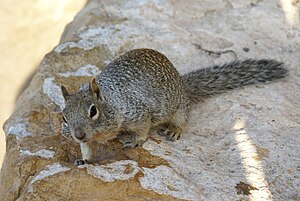Otospermophilus
| Otospermophilus | ||||||||||||
|---|---|---|---|---|---|---|---|---|---|---|---|---|

Rock Ground Squirrel ( Otospermophilus variegatus ) at the Grand Canyon |
||||||||||||
| Systematics | ||||||||||||
|
||||||||||||
| Scientific name | ||||||||||||
| Otospermophilus | ||||||||||||
| Brandt , 1844 |
Otospermophilus is a genus of real ground squirrels that is distributed in three species in North America.
features
The types of the genus are comparatively large and have a head-trunk length of about 38 to 58 centimeters. The tail is between 15.6 and 27.8 centimeters long, the tail length usually corresponds to between 70 and 90% of the body length. It is bushy and more like that of the tree squirrel than that of other ground squirrels. The ears are relatively large with 16 to 35 millimeters in length, the rear foot length is 51 to 68 millimeters. The coat is short and smooth. The species of the genus have a brown speckled to blotchy back, which results from the brown-sand-colored banding of the back hair. As a rule, the fur is darker in color in a strip that starts on the nose or forehead and runs along the middle of the back. They have light, crescent-shaped markings on the shoulders and neck.
Like the tail, the large ears , which are different from other ground squirrels, have also developed convergently in other tree-living squirrels, which is considered an adaptation to this way of life. Within the former ground squirrel, they also share this characteristic with the genus Notocitellus , which means that these two genera were sometimes viewed as closely related. The females of the Otospermophilus species have five to six pairs of teats .
The skull is relatively large, but not very broad compared to others. The skull is rounded, the tympanic bladder is very large. The molars are very large and relatively brachyodontic , the premolar P3 is very small with a height of usually less than 25% of the following P4. The incisors are erect (orthodont) or slightly backwards (ophistodont) with long tooth cavities.
distribution

The genus Otospermophilus is distributed in North America from the southwestern United States to central Mexico. Here, the distribution is of Baja California Ground Squirrel on the peninsula Baja California limited (Baja California), the California ground squirrel is in the extreme western North America from Washington and Oregon through California to Nevada before, the rock squirrel , in Idaho , Utah , southern Nevada and be found from western Texas to central Mexico.
Way of life
The species of the genus live mainly in dry habitats of the North American southwest, which extend up to the heights of the Rocky Mountains up to about 3,000 meters. All three species live as ground squirrels on the ground and form colonies; they build their burrows in mostly rocky habitats. The California ground squirrel is also found in agricultural areas and other habitats in the coastal mountain valleys. The species are, although mostly living on the ground, able to climb trees and bushes for foraging. They feed mainly on fruits and seeds.
Systematics
|
Phylogenetic systematics of the Marmotini according to Herron et al. 2004
|
Otospermophilus is a genus of squirrels , where they are assigned to the ground squirrels (Xerinae) and therein the real ground squirrels (Xerini). The first scientific description was made by Johann Friedrich von Brandt in 1844 with the rock goblet as a type. Then the species were assigned to the ground squirrel (genus Spermophilus ) together with other taxa that are now considered genera and treated as a subgenus.
In a molecular biological investigation, Otospermophilus was confirmed as a monophyletic group in 2004 , identified as a sister group of the genus Callospermophilus and newly described at the genus level. The taxon formed jointly with these stands opposite all of the rest of the Marmotini with the exception of the antelopesies ( Ammospermophilus ) and the genus Notocitellus as a sister group.
There are three types of the genus:
- Rock ground squirrel ( Otospermophilus variegatus ), southwestern United States, north and central Mexico
- California ground squirrel ( Otospermophilus beecheyi ), Oregon, California , Baja California
- Baja California ground squirrel ( Otospermophilus atricapillus ), Baja California
The name Otospermophilus is derived from the Greek words otos for "ear", spermatos for "seed" and phileo for "love", which translates as "ear-seed lover".
Hazard and protection
Both the rock ground squirrel and the California ground squirrel are classified by the International Union for Conservation of Nature and Natural Resources (IUCN) as "least concern" due to their comparatively large distribution area and stable stocks. The Baja California ground squirrel, on the other hand, is listed as an endangered species due to its limited and fragmented range and the fact that its populations, among other things, are decreasing due to hunting.
supporting documents
- ↑ a b c d e f g h Kristofer M. Helgen, F. Russell Cole, Lauren E. Helgen & Don E. Wilson: Generic revision in the Holarctic ground squirrel genus Spermophilus. Journal of Mammalogy, 90, pp. 270-305, 2009
- ↑ a b c Matthew D. Herron, Todd A. Castoe, Christopher L. Parkinson: Sciurid phylogeny and the paraphyly of holarctic ground squirrels (Spermophilus). Molecular Phylogenetics and Evolution 31, 2004; Pp. 1015-1030. ( doi : 10.1016 / j.ympev.2003.09.015 , full text , PMID 15120398 )
- ^ Richard W. Thorington Jr., John L. Koprowski, Michael A. Steele: Squirrels of the World. Johns Hopkins University Press, Baltimore MD 2012; Pp. 292-299. ISBN 978-1-4214-0469-1
- ↑ Notocitellus adocetus in the IUCN Red List of Threatened Species 2014.3. Posted by: AV Linzey, R. Timm, ST Álvarez-Castañeda, I. Castro-Arellano, T. Lacher, 2008. Accessed April 25, 2015., Otospermophilus beecheyi in the IUCN Red List of Threatened Species 2014.3. Posted by: AV Linzey, R. Timm, ST Álvarez-Castañeda, I. Castro-Arellano, T. Lacher, 2008. Accessed April 25, 2015.
- ↑ Otospermophilus beecheyi ssp. atricapillus in the IUCN Red List of Threatened Species 2014.3. Posted by: ST Álvarez-Castañeda, I. Castro-Arellano, T. Lacher, 2008. Accessed April 25, 2015.